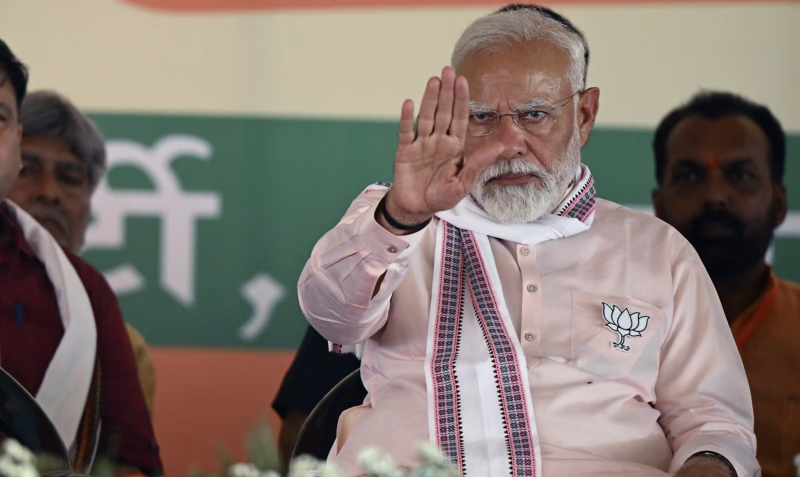
Incumbent Prime Minister Narendra Modi is turning up the wick on the communal, anti-Muslim rhetoric as India goes to the polls on May 7 in the third phase of the seven-stage elections in the world’s most populous democracy.
In recent days, Modi has made numerous fiery speeches. On May 7, while addressing a rally in Dhar in Madhya Pradesh, Modi suggested that Congress wanted to decide the national cricket team on religious grounds.
At an election rally in Rajasthan, Modi claimed that the Congress party’s manifesto sought to redistribute India’s land and wealth from the Hindu majority to the Muslim minority. He peppered his comments with an appeal to protect India’s married women, whose traditional gold ornaments would be expropriated and given to Muslims if Congress won. In the same speech, he referred to India’s Muslims as a community who produced too many children and as “infiltrators.”
Modi’s Bharatiya Janata Party (BJP) has routinely peddled a narrative by claiming that higher birth rates among the Muslim community will lead to Hindus being outnumbered by Muslims. Manufacturing anxieties and stoking fear around the demographic replacement and erasure of India’s 800 million strong Hindu community has been a favored tool during election season for India’s Hindu nationalist BJP.
Civil society groups and opposition parties were quick to take notice of Modi’s remarks, decrying the incumbent Prime Minister’s rhetoric as Islamophobic. Congress President Mallikarjun Kharge criticized Modi’s rhetoric as “hate speech,” suggesting that no Prime Minister had “lowered the dignity” of the office as brazenly as Modi. Kharge claimed that “people will remember Modi as the prime minister who resorted to divisive and communal rhetoric based on lies to avoid an inevitable electoral defeat.”
Doubling down on the Prime Minister’s baseless claims, the BJP social media machine released an animated video that parrots Modi’s use of pejorative stereotypes. The video shows an animated Rahul Gandhi holding up the Congress party’s manifesto, which morphs into a crescent moon and star against a green background, which was the pre-independence Muslim League’s official flag.
The symbology closely resembles Pakistan’s current flag and seeks to criticize the Congress as a Muslim appeasing party. In the video, Muslim citizens in India are depicted as invading soldiers going into battle wearing medieval armor, harkening back to Modi’s remarks calling Muslims “infiltrators.”
In another video released by the Karnataka BJP, an animated Rahul Gandhi is seen placing an egg marked “Muslims” in a nest with other eggs labelled “SC” (scheduled castes), “OBC” (other backward castes, a name that refers to marginalized castes), and “ST (scheduled tribes). When the eggs hatch, Gandhi is shown exclusively feeding the chick that hatches from the “Muslim” egg. The chick wears a Muslim skullcap and a rather menacing expression, ultimately outgrowing the other chicks and forcing them out of the nest.
While the video was taken down by Instagram, the BJP’s message could not be clearer. The party’s leadership is resorting to blatant Islamophobia. The party’s narrative machine has also sought to reduce complex local histories into simplistic binaries about Hindu-Muslim rivalry, with numerous claims about Muslims being responsible for the destruction of temples. The Hindu nationalist movement’s ideology corresponds closely with the BJP’s electoral narrative, which suggests that Hindus are the perpetual victims of marginalization at the hands of minorities, which necessitates strongman leadership without any consideration for democratic freedoms and institutions.
The BJP’s electoral success relies almost entirely on the consolidation of the Hindu electorate under the Hindutva banner, and in the ongoing election, it is patently obvious that fomenting communal polarization is the saffron party’s preferred campaign strategy.
The BJP’s brazen turn towards Islamophobic rhetoric is informed in part by fears of low voter turnout in BJP stronghold states like Uttar Pradesh, and of widespread voter apathy, even in districts where the party remains largely popular.
The BJP’s chances at winning a majority are also threatened by fears among the Scheduled Castes, Scheduled Tribes, Other Backward Classes, and the Extremely Backward Caste (EBC) groups that if the BJP were to win a third term, it would scrap reservation benefits that guarantee them affirmative action in education and employment opportunities. Since the BJP’s electoral equation relies on the Dalit vote, the party is pulling out all the stops to assuage fears about its sliding prospects.
Unfortunately for India’s 210 million Muslims, they continue to remain in the ruling party’s crosshairs, with the Prime Minister’s vitriolic rhetoric likely to leave Muslims vulnerable to violence at the hands of Hindutva political workers and operatives.
